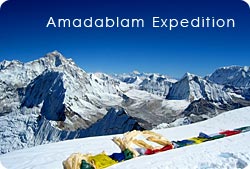Nepal- Altitude Sickness
Many people are concerned about altitude sickness. This problem, often known as Acute Mountain Sickness (AMS) is a particularly important medical consideration while trekking in Nepal and Tibet. Altitude illness rarely occurs lower than 2800 meters (9520ft ) and only minor symptoms occur below 3000 meters (9,800ft). AMS occurs when the body does not adapt well to less oxygen at higher altitudes. At 18,000 ft (5490m), there is one half the oxygen available as at sea level; on top of Mount Everest, only one third. The body tries to adapt to less oxygen by increasing the rate and depth of breathing, as well as the heart rate. Individual susceptibility to altitude sickness seems to be genetically determined.
-
What happens to the body during altitude illness?
Fluids accumulate in between the cells in the brain and/or the lungs, creating mild or severe symptoms. Mild symptoms include headache, loss of appetite, nausea, fatigue, lack of sleep and dizziness. These symptoms usually resolve by spending one or two extra nights at the same altitude. If symptoms worsens descent to lower altitudes is warranted..if you are resting at the same altitude and your symptoms are becoming worse, then it is also necessary to descend. More serious symptoms of AMS include increased tiredness, severe headache, vomiting,, loss of coordination, shortness of breath, cough. These extremely dangerous symptoms are called High Altitude Cerebral Edema (or HACE). They can lead to unconsciousness and death within 12 hours. Increasing shortness of breath, cough and tiredness may also be signs of High Altitude Pulmonary Edema or HAPE. HAPE can also be rapidly fatal if ignored. Respiratory depression (the slowing down of breathing) can be caused by various medications, and may be a problem at altitude. The following substances can do this and should never be used by someone who has symptoms of altitude illness : -
• Alcohol
• Sleeping pills (acetazolamide is the sleeping tablet of choice at altitude)
• Narcotic pain medications in more than modest dosesTo prevent AMS and respiratory depression, drink at least three litres of liquids a day and avoid getting cold. Altitude sickness can to a certain extent be prevented by acetazolamide (Diamox SR), 750mg per day. Some experts suggest a two-day trial before the trip. Please seek the advice of your personal physician. Please note that taking Diamox SR does not mean that you can ignore advice about proper acclimatization.
To recap, serious symptoms of altitude sickness include:
• A severe, enduring headache, which is not cured by ordinary painkillers
• Marked nausea and repeated vomiting
• Irritating dizziness or actual difficulty with balance and direction
• Visual disturbances with flickering vision and problems judging distance
• Pressure in the chest, rapid breathing and pulse rate, crackles in breathing and shortness of breath
• Swelling beneath the skin (edema), typically around the eyes
• Swollen ankles and hands
• Confusion
• Convulsions
In the presence of these symptoms, medical attention must be sought immediately in conjunction with descent to the lowest possible height.
-
Prevention of Altitude Illness:
-
- When mild symptoms develop, it is a signal that you must stay at that altitude until symptoms have gone away. Usually within one or two days you will feel well and can continue your trek.
If you are resting at the same altitude and your symptoms are becoming worse, then it is necessary to descend. Worsening symptoms of AMS including increasing tiredness, severe headache, vomiting, and loss of coordination. These are signs of High Altitude Cerebral Edema (or HACE). HACE can lead to unconsciousness and death within 12 hours if progressive symptoms are ignored. Increasing shortness of breath, cough, and tiredness are signs of High Altitude Pulmonary Edema or HAPE. HAPE can also be rapidly fatal if ignored. Increasing shortness of breath, cough, and tiredness are signs of High Altitude Pulmonary Edema or HAPE. HAPE can also be rapidly fatal if ignored.
- Respiratory depression (the slowing down of breathing) can be caused by various medications, and may be a problem at altitude. The following medications can do this, and should never be used by someone who has symptoms of altitude illness (these may be safe in non-ill persons, although this remains controversial):
-Alcohol
-Sleeping pills (acetazolamide is the sleeping tablet of choice at altitude)
-Narcotic pain medications in more than modest doses
- Drink plenty of liquids (at least three liters a day)
- Avoid getting cold.
- Altitude sickness can, to a certain extent, be prevented by acetazolamide (Diamox SR), 750mg per day from one day before ascent until two days after reaching the maximum height. Some experts suggest that to get to know the possible drug side effects it is wise to give it a two-day trial before the trip. This is an unlicensed use of this medicine, which is also only available on prescription, so it should only be undertaken on the advice of a doctor. Possible side effects include nausea: taste disturbance, tingling hands and feet, frequent and copious urination, visual disturbances and skin rash. However, taking Diamox SR does not mean people can ignore advice about slow ascent.
Note: We have guides trained at the High Altitude Medical Training Center. Our staff is very experienced in dealing with the effects of higher altitudes. As they are natives of Nepal, they easily acclimatize and therefore can care for their clients. They are equipped with necessary medical supplies and will assist you with basic first aid treatment. We design our tours to ensure clients are ready for high altitude, and arrange alternative itineraries for those at risk





